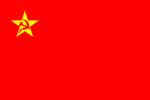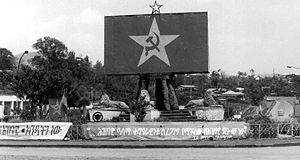- Workers' Party of Ethiopia
-
Workers' Party of Ethiopia
የኢትዮጵያ ሠራተኞች ፓርቲ
Founded September 12, 1984 Headquarters Addis Ababa, People's Democratic Republic of Ethiopia Newspaper Addis Zemen Ideology Communism,
Marxism-Leninism
See Politics of Ethiopia for more information.The Workers' Party of Ethiopia (Amharic: የኢትዮጵያ ሠራተኞች ፓርቲ?, Ye Ityopia Serategnoch Parti) is a Communist party in Ethiopia that was, from 1984 to 1990, the only legal political party in the country.
Contents
The Commission to Organize the Party of the Workers of Ethiopia
Following the 1974 revolution that led to Haile Selassie's ouster and eventual death in prison, the Soviet Union began to pressure the Derg to create a civilian-based vanguard party. Mengistu Haile Mariam, leader of the Derg and head of state of Ethiopia, argued against such a party, stating that the revolution had succeeded without one and that there was no need. However, by the late 1970s, in the face of increasing armed opposition to the Derg's rule, it became increasingly apparent that a civilian party would be required to gain any measure of control over the population. In December 1979, Mengistu announced the creation of the Commission to Organize the Party of the Workers of Ethiopia (COPWE).
A number of mass organisations, such as the Revolutionary Ethiopia Youth Association, were also established. It was hoped that these organisations would help lead to a unified party that would eliminate sectarianism and be based on broad (yet clearly defined) class interests. The organisations were also to act as the political consciousness of Ethiopia at a more personal level by not only representing Ethiopians at congresses, but also in the workplace and in educational institutes. Membership in multiple mass organisations was encouraged.
The COPWE held three congresses for the mass organisations it had set up, and despite the best efforts of the government to encourage diversity, more than one third of those present at the first congress, in 1980, were either soldiers or Addis Ababa residents.
The 1980 congress unveiled the membership of the COPWE's Central Committee and Secretariat. The Secretariat, which controlled the more day to day aspects of the Central Committee business and was supervised by the top Derg leadership, was composed of mainly civilian ideologues. Regional branches of the Secretariat coordinated by army officers helped complement the COPWE's central leadership. The organisation became more powerful in 1981 with the creation of separate offices for administrator and COPWE representative in each region.
By 1983, there were about 50,000 COPWE members and approximately 6,500 party cells. Despite Mengistu's earlier calls for ideological purity and the need for "committed communists", ideology soon became a simple façade for the Derg's efforts to eliminate its political opponents regardless of actual political beliefs, and loyalty to the Derg was preferred over dedication to Marxism-Leninism in considerations for party membership. By this time, the military and police had also become the majority in the membership of the Central Committee, with 79 of its 123 members being soldiers, twenty of whom were also Derg members.
The formation of the vanguard party
The Workers' Party of Ethiopia was finally established on September 12, 1984, to mark the tenth anniversary of the revolution. The COPWE was dissolved and the WPE took its place. The Central Committee was expanded to 183 members, with party congresses every five years. Mengistu became general secretary.
The WPE's Politburo, which replaced the COPWE's Executive Committee as Ethiopia's chief decision making body, had eleven members, seven of whom were drawn from the Derg and the remaining four being civilian ideologues and technocrats. Generally, Mengistu's wishes prevailed over any opposition. The nepotism involved in the selection of Politburo members meant that opposition to Mengistu was usually marginal anyway, making the entire council more of a mouthpiece for Mengistu's wishes than a legitimate government body.
At a national level, membership of the WPE was heavily slanted towards soldiers and members of certain ethnic groups that had, historically, endorsed the concept of a unified "greater Ethiopia", such as the Tigray and Amhara. However, at regional and local levels, ethnicity and military service became less relevant, with large numbers of civilians and members of various ethnicities in positions of power.
The WPE's position as "formulator of the country's development process and the leading force of the state and in society" was enshrined into law by the 1987 Ethiopian constitution, which also dissolved the Derg and renamed the country the People's Democratic Republic of Ethiopia. The constitution gave the party more political power than the government itself, with local party leaders given almost free rein provided their policies did not conflict with Addis Ababa's.
Demise
Amidst an armed insurrection, the end of Soviet support in 1990, and a concurrent move towards multi-party politics across Africa, the WPE's power began to unravel, and the party officially renounced Marxism and declared itself in favor of a mixed economy. Mengistu fled the country and the rebels took power in 1991. The new government disbanded the WPE and most of its leaders were put in prison for the crimes they allegedly committed during the party's rule.
External links
Categories:- Communist parties in Ethiopia
- History of Ethiopia
- Political parties in Ethiopia
- Ruling Communist parties
- Political parties established in 1984
- Political parties disestablished in 1991
Wikimedia Foundation. 2010.

